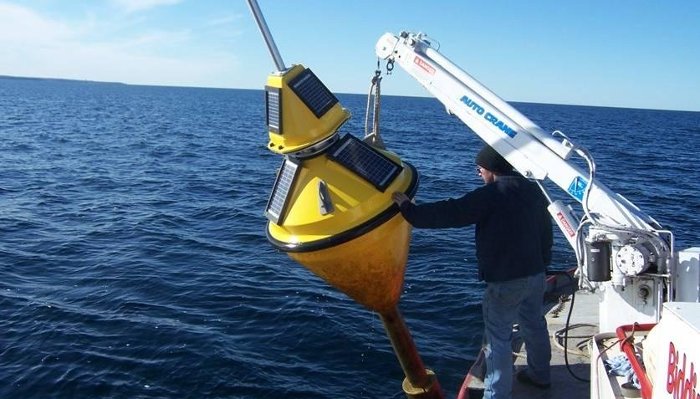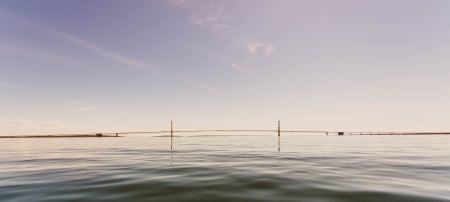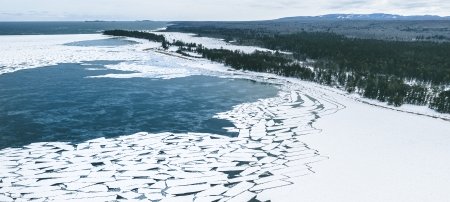Enbridge Engages Michigan Tech to Monitor Straits of Mackinac

Enbridge Energy Partners LP is calling on the expertise of Michigan Technological University’s Great Lakes Research Center (GLRC) to provide real-time environmental monitoring of the water conditions in the Straits of Mackinac. Enbridge Partners is sponsoring the GLRC’s efforts to integrate another monitoring buoy into the Upper Great Lakes Observing System (UGLOS). The GLRC will deploy, operate and disseminate data from the buoy for the benefit of all who use this important waterway.
Up to now, there have been limited real-time measurements in this environmentally and economically important section of the Great Lakes. “The Straits of Mackinac are probably the most heavily travelled portion of all the Great Lakes,” said Guy Meadows, GLRC director and leader of the Enbridge Partners-sponsored project.
Commercial shipping, the US Coast Guard, fishing, ferries and tourism all depend on the Straits, where Lake Michigan and Lake Huron meet. The confluence of these two large lakes causes complex and constantly changing currents and other conditions that affect those using the waterway. In addition, there are a variety of underwater structures in the area, such as Enbridge’s Line 5 and municipal utilities.
“Employing the expertise of the GLRC will provide important information to keep the Straits safe for everyone who uses the waterway,” said Dave Hoffman, senior manager of research, development and innovation for Enbridge Pipelines. “Enbridge Partners’ Line 5, which crosses under the Straits, is diligently monitored 24/7. The dual pipelines are operated and inspected using state-of-the-art tools and technologies. This buoy, also state-of-the-art, will give us additional data to enhance our legacy of safe operations that dates back for more than 60 years. Enbridge Partners is proud to be part of this project, which will benefit all who use and enjoy the Straits.”
The new buoy will be equipped with standard weather and wave sensors and an Acoustic Doppler Current Profiler (ADCP) that measures the flow of the water beneath the buoy by “looking downward” using sound waves. The ADCP will measure the magnitude and direction of currents at one-meter intervals from near the surface to the bottom.
The buoy will also measure wind direction and speed, wind gust speed, air temperature, relative humidity, barometric pressure, solar radiation, water temperature, wave height and direction.
“Enbridge Partners’ support allows us to further our development of advanced numerical predictive models for the Great Lakes,” Meadows said. “We will now be able to verify the predictions of the very complex flows through the Straits of Mackinac with real-time data from the buoy. It will also enable us to verify our new numerical hydrodynamic model of the combined Lakes Michigan and Huron.” The computer model is running on the GLRC's new supercomputer, nicknamed "Superior."
The buoy is being assembled at the GLRC in Houghton, Mich. It is anticipated that the buoy will be deployed this month, west of the Mackinac Bridge and on the Upper Peninsula side of the Straits, where the water is approximately 100 feet deep.
Once in operation, the data it collects will be displayed on the GLRC’s UGLOS website and updated every 10 minutes. All data will be accessible to the public at https://uglos.mtu.edu.
“We previously have worked with Michigan Tech and its GLRC to conduct inspections of Line 5,” said Hoffman. “We are impressed with the professionalism and expertise of the GLRC staff. When presented with this buoy-monitoring opportunity, Enbridge Partners was eager to sponsor this effort. This two-year project provides an additional layer of monitoring in the area to keep our pipelines safe and protect this sensitive and important waterway.”
Michigan Technological University is an R1 public research university founded in 1885 in Houghton, and is home to nearly 7,500 students from more than 60 countries around the world. Consistently ranked among the best universities in the country for return on investment, Michigan's flagship technological university offers more than 185 undergraduate and graduate degree programs in science and technology, engineering, computing, forestry, business, health professions, humanities, mathematics, social sciences, and the arts. The rural campus is situated just miles from Lake Superior in Michigan's Upper Peninsula, offering year-round opportunities for outdoor adventure.




Comments